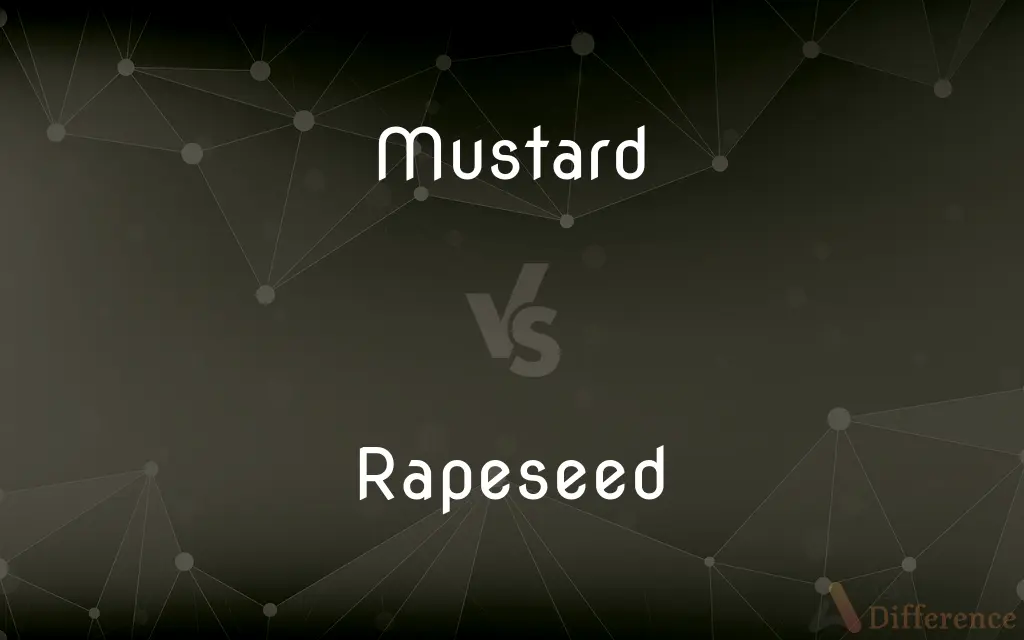Mustard vs. Rapeseed — What's the Difference?
By Tayyaba Rehman — Updated on August 21, 2023
Mustard refers to both a plant and its seeds used as a spice, while rapeseed is the seed of the rape plant, primarily used to produce oil.

Difference Between Mustard and Rapeseed
Table of Contents
ADVERTISEMENT
Key Differences
Mustard is a term that describes a variety of plants in the Brassicaceae family. These plants are cultivated for their seeds, which are ground into a powder to create the popular condiment we know today. Additionally, some varieties of mustard plants are cultivated for their leaves, which are used as greens in various cuisines. On the other hand, rapeseed comes from the Brassica napus plant. This plant is primarily cultivated for its seeds, which are processed to produce rapeseed oil, a common cooking oil.
Rapeseed and mustard have a rich history in agriculture. Mustard has been grown for thousands of years, with its seeds being used as a spice, and its greens being consumed as a vegetable. Rapeseed, on the other hand, has a more specific focus on oil production. Historically, the oil derived from rapeseed was used for lamps and industrial purposes, but modern varieties produce oil fit for human consumption.
Mustard, due to its strong flavor, has found its way into diverse cuisines, from Indian to French. The seeds can be ground to produce mustard paste, or left whole for pickling and other culinary uses. Rapeseed, in its oil form, is more neutral in taste, making it versatile for frying, baking, and other cooking methods. In addition to its culinary use, rapeseed oil is also a key ingredient in the production of biodiesel.
While both mustard and rapeseed are from the same family, they have distinct botanical characteristics. Mustard plants may produce yellow, white, or brown seeds depending on the variety. Rapeseed plants typically produce small, round, black seeds. However, it's essential to note that canola oil, a popular cooking oil, is derived from a specific type of rapeseed that has been bred to have lower erucic acid content.
Comparison Chart
Primary Use
Spice and condiment, also consumed as greens
Oil production for cooking and industrial purposes
ADVERTISEMENT
Flavor
Strong and pungent
Neutral (especially in oil form)
Seed Color Varieties
Yellow, white, or brown depending on the variety
Typically black
Historical Use
Consumed for thousands of years as a spice
Primarily for oil, including for lamps
Botanical Relatives
Various species within the Brassicaceae family
Primarily Brassica napus
Compare with Definitions
Mustard
A plant of the Brassicaceae family cultivated for its seeds and leaves.
They grew mustard in their backyard garden for its spicy seeds and tender greens.
Rapeseed
Rapeseed (Brassica napus subsp. napus), also known as rape, or oilseed rape, is a bright-yellow flowering member of the family Brassicaceae (mustard or cabbage family), cultivated mainly for its oil-rich seed, which naturally contains appreciable amounts of erucic acid.
Mustard
The yellow or brownish-yellow condiment made from ground mustard seeds.
She added mustard to her sandwich for an extra kick.
Rapeseed
A bright yellow-flowering plant from the Brassicaceae family.
Fields of rapeseed in bloom can be seen from miles away due to their vibrant color.
Mustard
A hot-tasting yellow or brown paste made from the crushed seeds of certain plants, typically eaten with meat or used as a cooking ingredient
Dijon mustard
Mustard sauce
Rapeseed
The seed of the rape plant, used primarily for oil extraction.
Rapeseed oil is a staple in many kitchens due to its neutral flavor.
Mustard
A powder or a paste made from the seeds of black or white mustard, used as a condiment and a rubefacient. Taken internally it is stimulant and diuretic, and in large doses is emetic.
Rapeseed
An oil extracted from the seeds of the rape plant.
She used rapeseed oil to fry the potatoes, ensuring they were crispy.
Mustard
A dark yellow color resembling the hue of some mustards.
He painted his room a soothing shade of mustard.
Rapeseed
A source for biodiesel production.
Many industries are looking at rapeseed as a sustainable biodiesel option.
Mustard
Dark yellow colour, the colour of mustard.
Rapeseed
The rape plant or its seed.
Mustard
A sharp, pungent taste or flavor.
The dressing had a mustard zing that enlivened the salad.
Rapeseed
The seed of the rape plant, Brassica napus, used widely for animal feed and vegetable oil.
Mustard
A forceful or potent quality.
Her speech had the mustard to motivate everyone in the room.
Rapeseed
A crop cultivated in temperate climates worldwide.
Farmers in the region have been growing rapeseed for decades, capitalizing on its demand.
Mustard
Leaves eaten as cooked greens
Rapeseed
The rape plant itself.
Mustard
The yellow-flowered Eurasian plant of the cabbage family whose seeds are used to make mustard.
Rapeseed
Seed of rape plants; source of an edible oil
Mustard
A brownish yellow colour
A mustard sweater
Mustard
Any of various Eurasian plants of the mustard family, especially white mustard, Indian mustard, and black mustard, which are cultivated for their pungent seeds and edible leaves.
Mustard
A condiment made from the powdered seeds of certain of these plants.
Mustard
A member of the mustard family.
Mustard
A dark yellow to light olive brown.
Mustard
Any of a group of toxic organic compounds that include mustard gas and the nitrogen mustards.
Mustard
A plant of certain species of the genus Brassica, or of related genera (especially Sinapis alba, in the family Brassicaceae, with yellow flowers, and linear seed pods).
Mustard
Powder or paste made from seeds of the mustard plant, and used as a condiment or a spice.
When the waitress brought the food, I asked whether she had any Dijon mustard.
Mustard
The leaves of the mustard plant, used as a salad.
Mustard and cress sandwiches.
Mustard
One of a family of vesicants containing one or more 2-chloroethyl (C2H4Cl) groups, commonly used in chemical warfare and cancer chemotherapy.
Mustard
The tomalley of a crab, which resembles the condiment.
Mustard
Of a dark yellow colour.
Mustard
The name of several cruciferous plants of the genus Brassica (formerly Sinapis), as white mustard (Brassica alba), black mustard (Brassica Nigra), wild mustard or charlock (Brassica Sinapistrum).
Mustard
Any of several cruciferous plants of the genus Brassica
Mustard
Pungent powder or paste prepared from ground mustard seeds
Common Curiosities
What are the primary uses of mustard and rapeseed?
Mustard is predominantly used as a spice and condiment, while rapeseed is used mainly for oil extraction.
How are mustard and rapeseed related?
Both mustard and rapeseed belong to the Brassicaceae family, making them botanical relatives.
Can I use rapeseed oil as a substitute for mustard oil?
While both oils come from the Brassicaceae family, mustard oil has a strong flavor, whereas rapeseed oil is neutral. They can be used interchangeably in cooking, but the taste will differ.
Is mustard only a condiment?
No, mustard refers to the plant, its seeds, and the condiment made from the seeds. Some varieties are also grown for their edible greens.
What is the difference between canola oil and rapeseed oil?
Canola oil is derived from a specific type of rapeseed that has lower erucic acid, making it more suitable for human consumption.
Why do fields of rapeseed appear so bright yellow?
Rapeseed plants produce vibrant yellow flowers, making entire fields bloom in a striking yellow hue during the flowering season.
Are there different types of mustard seeds?
Yes, mustard seeds come in various colors, including yellow, white, and brown, each with a slightly different flavor profile.
Why is rapeseed oil considered a versatile cooking oil?
Rapeseed oil has a high smoke point and a neutral taste, making it suitable for various cooking methods, from frying to baking.
How have the uses of mustard and rapeseed evolved over time?
While mustard has been used as a spice for thousands of years, rapeseed was initially used for lamps and industrial purposes. Modern rapeseed varieties are now grown for culinary oil production.
Do mustard and rapeseed have medicinal properties?
Historically, both mustard and rapeseed have been used in traditional medicine, with mustard being used for its warming properties and rapeseed oil for its moisturizing effects.
Share Your Discovery

Previous Comparison
Cow vs. Bull
Next Comparison
Ops vs. OopsAuthor Spotlight
Written by
Tayyaba RehmanTayyaba Rehman is a distinguished writer, currently serving as a primary contributor to askdifference.com. As a researcher in semantics and etymology, Tayyaba's passion for the complexity of languages and their distinctions has found a perfect home on the platform. Tayyaba delves into the intricacies of language, distinguishing between commonly confused words and phrases, thereby providing clarity for readers worldwide.
















































